October 16, 2014
By David L. Taylor
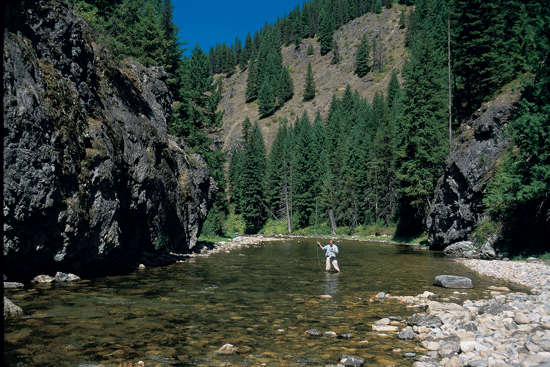 During hatchless hours, Kelly Creek cutthroat take Western attractor drys and nymphs fished in current seams created by rocks and logs. Photo: Steve Pettit
During hatchless hours, Kelly Creek cutthroat take Western attractor drys and nymphs fished in current seams created by rocks and logs. Photo: Steve Pettit
Thousands of fly fishers will travel to Idaho every year to fish the fabled waters of the Henry's Fork, Silver Creek, and the Middle Fork of the Salmon River. While these waters are some of the best and most popular fly-fishing destinations in the U.S., other Idaho waters remain virtually unknown despite their wonderful fishing opportunities.
Far to the north of the Henry's Fork, Kelly Creek, one of Idaho's best-kept angling secrets, flows into the North Fork of the Clearwater. This little gem offers anglers gin-clear water and native cutthroat trout in the quiet solitude of a mountain stream. It's a place where you feel like you have the river and its superb fly fishing all to yourself. Other great streams in the area include Cayuse Creek, a tributary to Kelly Creek, and Weitas Creek, another tributary to the North Fork.
Kelly Creek begins high in the mountains of the Idaho panhandle, far from civilization, and runs as clean and clear today as it did 100 years ago. In this unspoiled high-mountain freestoner, native West Slope cutthroats up to 20 inches leap to take a fly and then dive for the bottom. It's a special place and an exceptional river.
Advertisement
 Kelly Creek's boulder-lined runs and long slow pools (above) hold large West Slope cutthroat, like this 19-incher. The creek has benefited from catch-and-release regulations since 1970. Photo: Tom Herrera
Kelly Creek's boulder-lined runs and long slow pools (above) hold large West Slope cutthroat, like this 19-incher. The creek has benefited from catch-and-release regulations since 1970. Photo: Tom Herrera
August on Kelly Creek
When Deschutes River guide Greg Larsen suggested a trip to Kelly Creek for early August 1996, I quickly agreed to accompany him. I grew up near the confluence of the Snake and Clearwater rivers and had fished Kelly Creek as a child in the 1950s. I was anxious to revisit the area with a fly rod to unlock its fishing secrets.
Greg's parents, now retired, were camp hosts at the Washington Creek Campground, a U.S. Forest Service facility on the North Fork of the Clearwater, 17 miles downriver from Kelly Creek. So we stayed there and planned on a daily fishing commute up along the North Fork to Kelly Creek.
Advertisement
We thought we would find the best fly fishing in Kelly Creek, because it has had catch-and-release regulations since 1970. But each morning as we drove along the North Fork river road on our way to Kelly Creek, we discovered promising water; we had to stop to fish. We enjoyed excellent fishing in riffles, corners, and boulder-lined runs along the North Fork, catching and releasing from 10 to 15 nice cutts in two days of nonstop fishing, finally reaching Kelly Creek on our third day. But when we did, we found the fishing there to besuperb.
We fished mostly drys but also had success with nymphs and emergers. The largest fish were taken on an October caddis pupa, which the fish mistook for the large cased caddis that cover the river's rocks. These caddis fashion their cases from the streambed's pinkish-brown gravel, which gives them a light-brown case with a black head and black legs visible at the tip. Trout pluck the naturals from the rocks or devour them as they wash downstream. Although we fished nymphs successfully throughout the day, we caught most of the trout on drys. In the evenings by our campfire, we planned a return to Kelly Creek in the fall to meet the October caddis hatch.
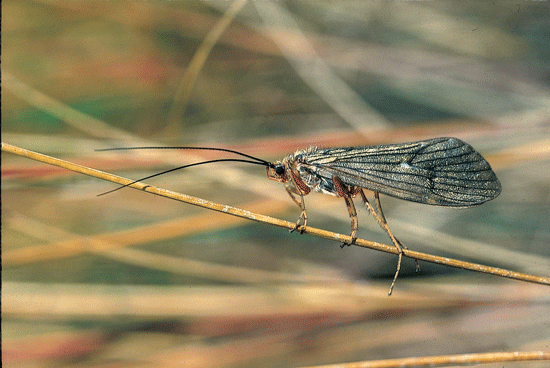 In the fall, October caddis hatches bring Kelly Creek's cutthroat to the surface. A variety of heavily hackled caddis drys take fish, but nymphs fished among the rocks take more large trout. Photo: Steve Pettit
In the fall, October caddis hatches bring Kelly Creek's cutthroat to the surface. A variety of heavily hackled caddis drys take fish, but nymphs fished among the rocks take more large trout. Photo: Steve Pettit
Meeting the October Caddis on Kelly Creek
Greg Larsen was busy guiding steelheaders on the Deschutes in the fall, so Tom Herrera and I returned for the caddis hatch in the first week of October 1996. The morning temperatures were cool, but once the sun warmed the air, the cutts responded to drys. The fishing was relaxed and comfortable, with the mountains garbed in golden aspen. October caddis adults rested on the streamside trees and bushes, and trout responded eagerly to #8 to #14 Elk-hair Caddis and Stimulators.
We fished mayfly, small caddis, and attractor imitations successfully throughout the day. Then in early afternoon, large, clumsy caddis appeared over the stream and skippedand bounced across the surface, and the trout began to slash in earnest. We cast our large imitations into the fast water, short-lined them into turbulent pocketwater, and floated them drag-free in the quiet water beside the current seams. The cutts took our Elk-hairs greedily.
Fast-water Fly Fishing Techniques
Kelly Creek is not a large stream, but it is fast-flowing and turbulent, with a steep gradient and a bouldered freestone streambed. The swift, boulder-filled runs and pocketwaters can produce 30-fish days when you fish drys upstream on short casts or high-stick heavily weighted nymphs upstream through the pockets and runs. When using these techniques, you must strip fast to control your line and wade aggressively (using a wading staff and boots with good ankle support).

Kelly Creek's boulder-lined runs (above) and long slow pools hold large West Slope cutthroat, like this 19-incher. The creek has benefited from catch-and-release regulations since 1970. Photo: Steve Pettit
This is classic pocketwater fishing. When you fish a dry in the fast, broken water, your success depends more on a drag-free presentation than on your ability to match the hatch. Your casts are often short, but your fly falls into strong currents and cross-currents that instantly create drag. A 9-foot or longer rod and an 8-foot, 4X or 5X leader allow you to keep your floating line and most of your leader off the water so you control drag. And it often takes more than one cast to produce a drift that floats drag-free and fools the trout. Your first cast is experimental; then you refine your drifts with better fly placement and rapid line mending to counteract drag.
The rough-surfaced fast water helps conceal your presence from the trout. You make multiple casts to each pocket without spooking the fish, which must make eat-or-don't-eat decisions quickly. The pocketwater holds many trout per mile, but most of the fish are in the 10- to 14-inch range, with the larger trout holding in the slower water adjacent to the fastwater feeding lanes. To catch these trout, you must work the seams, the deeper pockets, and the cushion water in front of boulders.
During hatchless hours, cutts jump and somersault to take heavily-hackled Western attractor drys (#16-#18 Elk-hair Caddis, Parachute Adams, Royal Wulff, and Humpy) cast to holding lies behind rocks, beside logs, and in the seams.
You can fish your nymphs (bead-heads, weighted or unweighted) deep or in the film as emergers. And, as in most freestone rivers, nymphing allows you to present your fly to the larger trout that are too cautious to feed at the surface. When using short casts, you must hold your rod tip high, keeping all but your leader off the surface and using a strike indicator for better strike detection. Slide your indicator down to within two or three feet of the nymph to detect the more subtle strikes in turbulent, shallow water.
Effective nymph patterns include the Pheasant Tail, Hare's Ear (also in bead-head), and Olive Bead-head. Fish these alone or as a trailer beneath a weighted stonefly nymph or cased-caddis pattern. This combination offers the trout a choice between two good imitations of naturals they eat. You can also use a heavily-hackled dry as an indicator with a nymph dropper tied off the hook bend or eye.
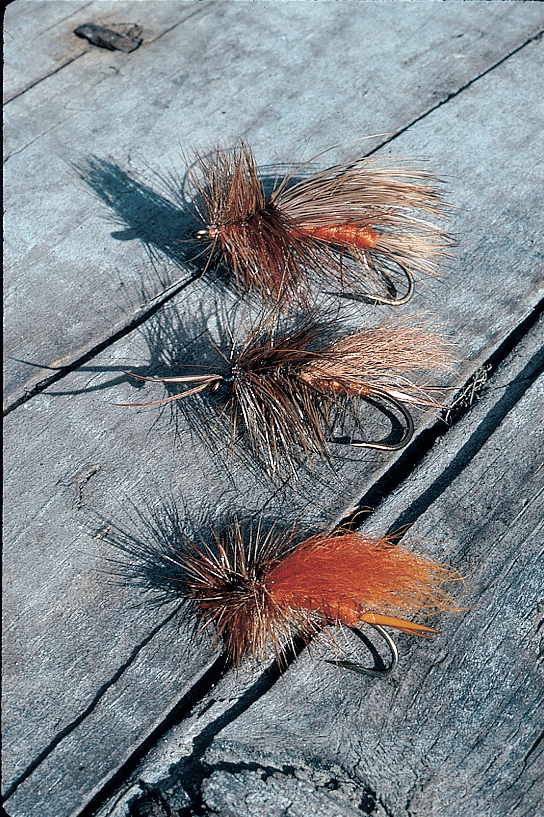 In the fall, October caddis hatches bring Kelly Creek's cutthroat to the surface. A variety of heavily hackled caddis drys take fish, but nymphs fished among the rocks take more large trout. Photo: Tom Herrera
In the fall, October caddis hatches bring Kelly Creek's cutthroat to the surface. A variety of heavily hackled caddis drys take fish, but nymphs fished among the rocks take more large trout. Photo: Tom Herrera
Flies and Tackle for Kelly Creek
Although freestone streams seldom have prolific hatches, Kelly Creek has a surprising number of caddis, mayflies, and stoneflies that hatch from early spring into fall. Brown, tan, olive, and black Elk-hair Caddis (#12 - #16) cover most of the season's caddis hatches. Mayflies are represented with various tan, olive, gray, and yellow patterns (#12-#18). Drys for fastwater presentations should be tied with a heavier wrap of hackle than normal, and tails of elk or moose hair help these patterns float in fast water. In quieter runs, a parachute-style pattern presents a more realistic profile to the trout and helps you see your fly on the water.
In early June, a hatch of large stoneflies usually coincides with the high water of spring runoff. A #6-#10 black, brown, or tan stonefly nymph pattern fished deep, either alone or with a dropper, can be productive throughout the season. Runoff usually ends in mid-July.
In late summer, a grasshopper, beetle, or ant pattern drifted through a feeding lane will draw vigorous strikes. On one hot August afternoon, I spotted a large trout rising in slow water next to a bank under an overhanging tree branch. I drifted a black ant under the branch downstream and tempted the fish into an enthusiastic strike. The cutthroat measured just over 20 inches and was my largest fish of the trip.
From mid-September through October, both the North Fork and Kelly Creek have strong October caddis hatches (yellowish-orange) and they bring the largest trout to the surface. A #8-#14 October caddis nymph or adult dry-fly pattern will produce some of the best fishing of the season.
A 5- or 6-weight rod with a floating line is all you need. Wading shoes and a wading staff are a must for safe wading in the fast, rugged water. Although you can wade wet in the summer, it's more comfortable to wear waders for early-morning and late-evening fishing. Even in summer, the evenings can be cold, especially if you are wet. Carry rain gear: Although summer daytime temperatures can be in the 90s (F.), afternoon and evening thunderstorms can rumble through the canyons.
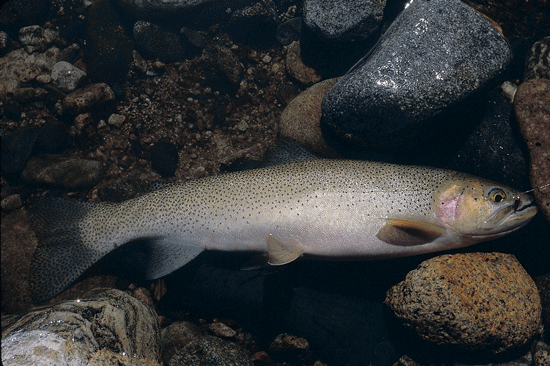 In the fall, October caddis hatches bring Kelly Creek's cutthroat to the surface. A variety of heavily hackled caddis drys take fish, but nymphs fished among the rocks take more large trout. Photo: Steve Pettit
In the fall, October caddis hatches bring Kelly Creek's cutthroat to the surface. A variety of heavily hackled caddis drys take fish, but nymphs fished among the rocks take more large trout. Photo: Steve Pettit
If You Go
To reach Kelly Creek and the North Fork of the Clearwater, take U.S. 12 east out of Lewiston, Idaho, for about 42 miles to Orofino. Follow U.S. 12 from Orofino 8 miles to the town of Greer. Take Idaho Route 11 from Greer 28 miles to the small town of Pierce. Follow Forest Route 250 from Pierce 16 miles down to the North Fork.
Narrow paved roads lead from Orofino to the river, with the last six miles good gravel road. When you reach the North Fork of the Clearwater River, cross the bridge and turn left for 17 miles of downstream fishing, or turn right for 19 miles of upstream fishing. The upstream access includes seven miles of road adjacent to Kelly Creek. If you want to leave the roadside fishing behind, use the trail leading upriver from the end of the road on Kelly Creek.
There are seven campgrounds along the North Fork and Kelly Creek that offer more than 100 sites, with safe drinking water, picnic tables, and toilets.
Cayuse and Weitas creeks are mountain streams similar to Kelly Creek, although smaller. They both have large populations of wild westslope cutthroat trout in the 12- to 14-inch range; Weitas Creek has a few wild rainbows.
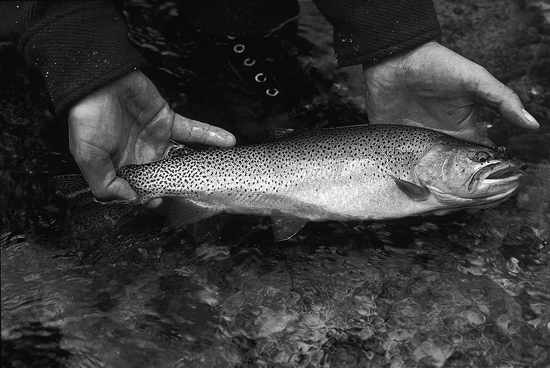 Kelly Creek's boulder-lined runs and long slow pools hold large West Slope cutthroat, like this 19-incher (above). The creek has benefited from catch-and-release regulations since 1970. Photo: Steve Pettit
Kelly Creek's boulder-lined runs and long slow pools hold large West Slope cutthroat, like this 19-incher (above). The creek has benefited from catch-and-release regulations since 1970. Photo: Steve Pettit
When to Go
Kelly Creek and the North Fork of the Clearwater are open from the Saturday of Memorial Day weekend through November 30. The best time of year to fish is from the end of spring runoff (usually mid-July) until the season closes.
In June, the water may be too high with runoff to wade safely. July brings lower water levels and warmer days and nights, continuing into early September. By mid-September the mornings and evenings are cool, but the days are comfortable and provide some of the year's best fishing. You should remember that winter comes early in the mountains and be prepared with warm clothing.
We camped one night at the confluence of Kelly Creek and the North Fork of the Clearwater after a full day of fishing the October caddis hatch. As we sat by the dying embers of our campfire, we watched a distant display of the northern lights and marveled at how few anglers we had seen that day. We agreed that Kelly Creek and the North Fork offer fly fishers the opportunity to fish in near-magical surroundings for native trout that can approach 20 inches.
The remote location of these streams keeps the number of visiting anglers to a minimum. The insect hatches are steady and plentiful, and the trout are willing. The streams provide an opportunity to leave the crowds behind and enjoy exceptional trout fishing in an incredible mountain setting.
David L. Taylor retired last year and now works part-time at the Columbia Gorge Fly Shop in Hood River, Oregon.
